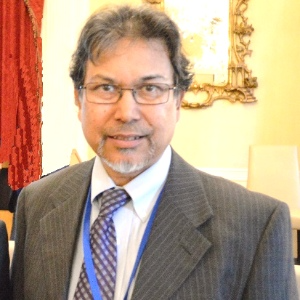Title : Nanotechnology and T-ray imaging for enabling a smarter AI and LLMs for medical diagnostics and other applications
Abstract:
Artificial intelligence (AI) or digital intelligence has spared a wave in modern computing community for its interactive applications. However, AI is not capable of creating new knowledge or new concepts; it only finds results from what is already known, but its ability for massive search and algorithm crunching for arriving at conclusions is remarkable. In other words, AI is not a thinking machine, nor it can ever become a concious entity, although its role in pattern matching and automation is undeniable due to the modern neural network algorithms and other AI tools. So, why AI cannot create new knowledge. How could nanotechnology help AI to assemble new knowledge.
We have seen that the advent of nanotechnology enhances just about any area of modern technology, from agriculture to semiconductors, and beyond. So, “can nanotechnology enhance the AI for knowledge creation?” The answer unfortunately is not a straightforward yes or no. However, at the current stage, nanotechnology could play a pivotal role in augmenting AI’s ability towards assembling new knowledge by enabling advancements in nanomaterials, nanosensors, and higher computational capacities. A few keyways nanotechnology could empower AI will include enhanced computing power: Nanocomputing leverages nanoscale materials and designs to significantly increase computing power, providing AI systems with more robust computational abilities to process complex data sets and algorithms. The main power of any AI systems (e.g., a large language model, “LLM”) comes from the computations it performs to sort out the huge libraries on which it is trained, and thus match the most probable answer. Therefore, if the computing power is enhanced that will certainly help enhancing the scope of AI, such as handling even bigger training space than currently possible. Examples include, constructing neural networks with even more parameters and tokens specific to a given LLM, higher order computations of the integro-differential equations for weather forecasting, and/or sorting LLMs with more parameters and tokens for a stockmarket, etc. Therefore, faster, and cheaper computing power is a definite enhancement for AI, which can be enabled by nanotechnology.
T-ray imaging can be useful for AI applications in several ways. High-resolution imaging for data analysis: T-ray imaging provides very high-resolution data, which can be analyzed using AI techniques such as machine learning (ML), deep learning (DL), and reinforcement learning (RL). AI can be used to interpret the large complex datasets generated by T-ray imaging, enabling applications in non-destructive evaluation, biomedical diagnosis, security screening, and materials characterization. The lattice image of nickel shown in Fig. 1 was generated by T-ray nanoscanning 3D imaging system. These images were used for quantification of lattice dilation [1], which is the begenning of embrittlement in many metallic structures, leading to damage and failure. Such image can be pixelated and fed into an LLM for identifying and predicting failure mechanism before the occurance of actual failure.
Another specific example of AI-assisted T-ray imaging for medical applications is the acute lung injury therapy. In this case, AI-assisted T-ray image could be employed to identify biological tissue samples encased in paraffin, demonstrating its potential for medical diagnosis and therapeutic purposes. AI-assisted T-ray imaging can enhance the accuracy and efficiency of cancer detection and diagnosis. These examples highlight the potential of AI-assisted T-ray imaging in biomedical applications for cancer detection, tissue health monitoring, etc., thus advancing healthcare technologies. Some details of the T-ray technique will be discussed in terms of real-world data.


